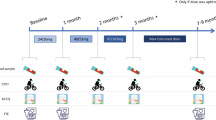Summary
Background. Fabry disease is an X-linked genetic disorder resulting in the accumulation of glycosphingolipids in various organs, leading to exercise intolerance and early mortality. Enzyme replacement therapy (ERT) has recently been approved for use in Fabry patients. Goals of study. To assess baseline cardiopulmonary exercise characteristics in both invasive and noninvasive tests and to study the impact of ERT on exercise. Methods. A total of 15 patients with Fabry disease underwent baseline cardiopulmonary exercise tests. Six patients were randomized 2:1 to receive either ERT or placebo. We performed serial cardiopulmonary exercise tests at baseline and every 3 months over a period of at least 18 months. The baseline test was compared to the last two exercise tests for each patient. Results. Mean age was 32 years. Mean VO2 max was 1.680 ± 0.67 L/min and increased by 0.459 ± 0.64 L/min in the patients receiving ERT. Mean VO2 max was 1.462 ± 0.25 L/min and decreased by 0.116 ± 0.44 L/min in patients on placebo. Mean oxygen pulse (VO2/HR) increased by 1.71 with enzyme, but increased only 0.025 in patients taking placebo. Estimated stroke volume (SV) increased by 10 ml in patients on ERT. Conclusions. In this small cohort, exercise tolerance increased in patients receiving enzyme replacement therapy. Cardiopulmonary exercise testing is a useful test in measuring the response to therapy in Fabry disease patients.
Similar content being viewed by others
Abbreviations
- AT:
-
anaerobic threshold
- CO:
-
cardiac output
- DL/VA:
-
diffusing capacity to alveolar volume ratio
- DLco:
-
average diffusing capacity
- ERT:
-
enzyme replacement therapy
- FEF25–75:
-
forced expiratory fraction from 25% to 75% of the total exhalation
- FEV1:
-
forced expiratory volume in one second
- FVC:
-
forced vital capacity
- HR:
-
heart rate
- SV:
-
stroke volume
- VD/Vt:
-
dead space to tidal volume ratio
- VE/VCO2:
-
minute ventilation per CO2 production
- VO2:
-
maximum oxygen uptake measured at peak exercise
- VO2/HR:
-
mean oxygen pulse
References
American Thoracic Society (1991) Lung function testing: selection of reference values and interpretative strategies. Am Rev Respir Dis 144: 1202–1218.
American Thoracic Society (1995) Standardization of spirometry: 1994 update. Am J Respir Crit Care Med 152: 1107–1136.
Banikazemi M, Ullman T, Desnick RJ (2005) Gastrointestinal manifestations of Fabry disease: clinical response to enzyme replacement therapy. Mol Gen Metab 85(4): 255–259.
Bartimmo EE, Guisan M, Moser K (1972) Pulmonary involvement in Fabry's disease: a reappraisal. Am J Med 53: 755–764.
Beaudet AL, Sly WS, Valle D, Scriver CR, eds (1995) The Metabolic and Molecular Bases of Inherited Disease, 7th edn. New York: McGraw-Hill, 2743.
Beck M, Ricci R, Widmer U, et al. (2004) Fabry disease: overall effects of agalsidase alfa treatment. Eur J Clin Invest 34(12): 838–844.
Bierer G, Kamangar N, Balfe D, Wilcox WR, Mosenifar Z (2005) Cardiopulmonary exercise testing in Fabry disease. Respiration 72: 504–511.
Brown LK, Miller A, Bhuptani A, et al (1997) Pulmonary involvement in Fabry disease. Am J Respir Crit Care Med 155: 1004–1010.
Crapo RO, Morris AH (1981) Standardized single breath normal values for carbon monoxIDe diffusing capacity. Am Rev Respir Dis 123: 185–189.
Eng CM, Guffon N, Wilcox W, et al (2001) Safety and efficacy of recombinant human α-galactosidase A replacement therapy in Fabry's disease. New Engl J Med 345(1): 9–16.
Kelly MM, Leigh R, McKenzie R, Kamada D, Ramsdale EH, Hargreave FE (2000) Induced sputum examination: diagnosis of pulmonary involvement in Fabry's disease. Thorax 55(8): 720–721.
Linhart A, Palecek T, Bultas J, et al (2000) New insights in cardiac structural changes in patients with Fabry's disease. Am Heart J 139(6): 1101–1008.
Peironi M, Chimenti C, Russo A, Russo MA, Maseri A, Frustaci A (2004) Tissue Doppler imaging in Fabry disease. Curr Opin Cardiol 19(5): 452–457.
Pieroni M, Chimenti C, Ricci R, Sale P, Russo MA, Frustaci A (2003) Early detection of Fabry cardiomyopathy by tissue Doppler imaging. Circulation 107(15): 1978–1984.
Rosenberg DM, Ferrans VJ, Fulmer JD, et al (1980) Chronic airflow obstruction in Fabry's disease. Am J Med 68: 898–905.
Rosenberg E (1996) The 1995 update of recommendations for a standard technique for measuring the single-breath carbon monoxide diffusing capacity (transfer factor). Am J Respir Crit Care Med 54(3 Pt 1): 827–828.
Rowland TW (2005) Circulatory responses to exercise: are we misreading Fick? Chest 127(3): 1023–1030.
Sheth KJ, Thomas JP Jr (1982) Electrocardiograms in Fabry's disease. J Electrocardiol 15(2): 153–156.
Stringer WW, Hansen JE, Wasserman K (1997) Cardiac output estimated noninvasively from oxygen uptake during exercise. J Appl Physiol 82(3): 908–912.
Wasserman K, Hansen JE, Sue DY, Stringer WW (1999) Principles of Exercise Testing and Interpretation, 3rd edn. Philadelphia: Lippincott Williams & Wilkins.
Yoshida K, Murase M, Maseki T, Usui A, Ina H, Abe T (1989) Transvenous permanent pacemaker implantation for Fabry's disease. 3 cases report. Nippon Kyobu Geka Gakkai Zasshi–-J Jpn Assoc Thorac Surg 37(2): 386–390.
Author information
Authors and Affiliations
Corresponding author
Additional information
Communicating editor: Douglas Brooks
Competing interests: W. R. Wilcox is a paid consultant of Genzyme Corp. and is on the Genzyme Speakers Bureau. Neither he nor his relations own Genzyme stock. Genzyme Corp. provided a research grant for the study
Rights and permissions
About this article
Cite this article
Bierer, G., Balfe, D., Wilcox, W.R. et al. Improvement in serial cardiopulmonary exercise testing following enzyme replacement therapy in Fabry disease. J Inherit Metab Dis 29, 572–579 (2006). https://doi.org/10.1007/s10545-006-0361-5
Received:
Accepted:
Issue Date:
DOI: https://doi.org/10.1007/s10545-006-0361-5




